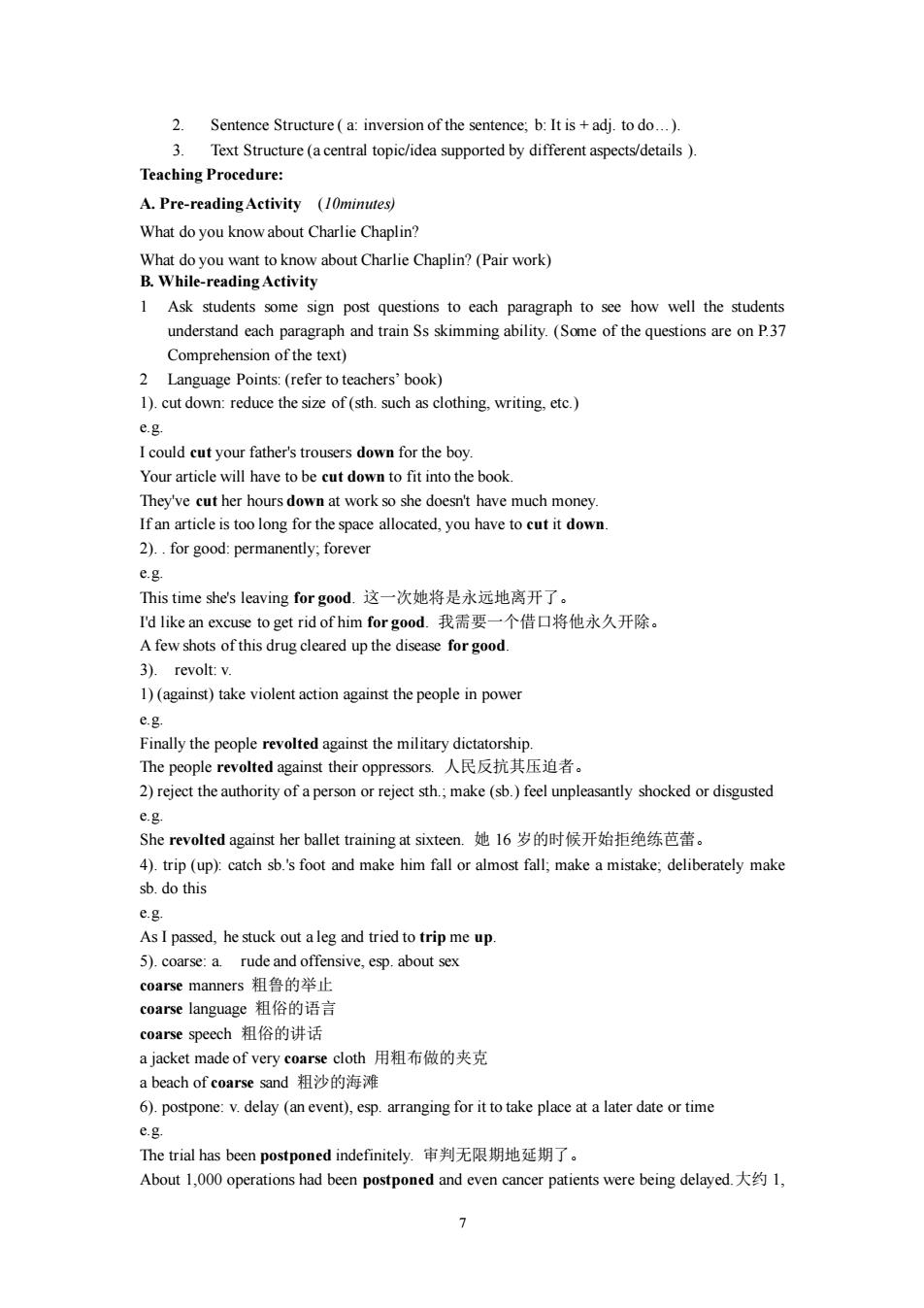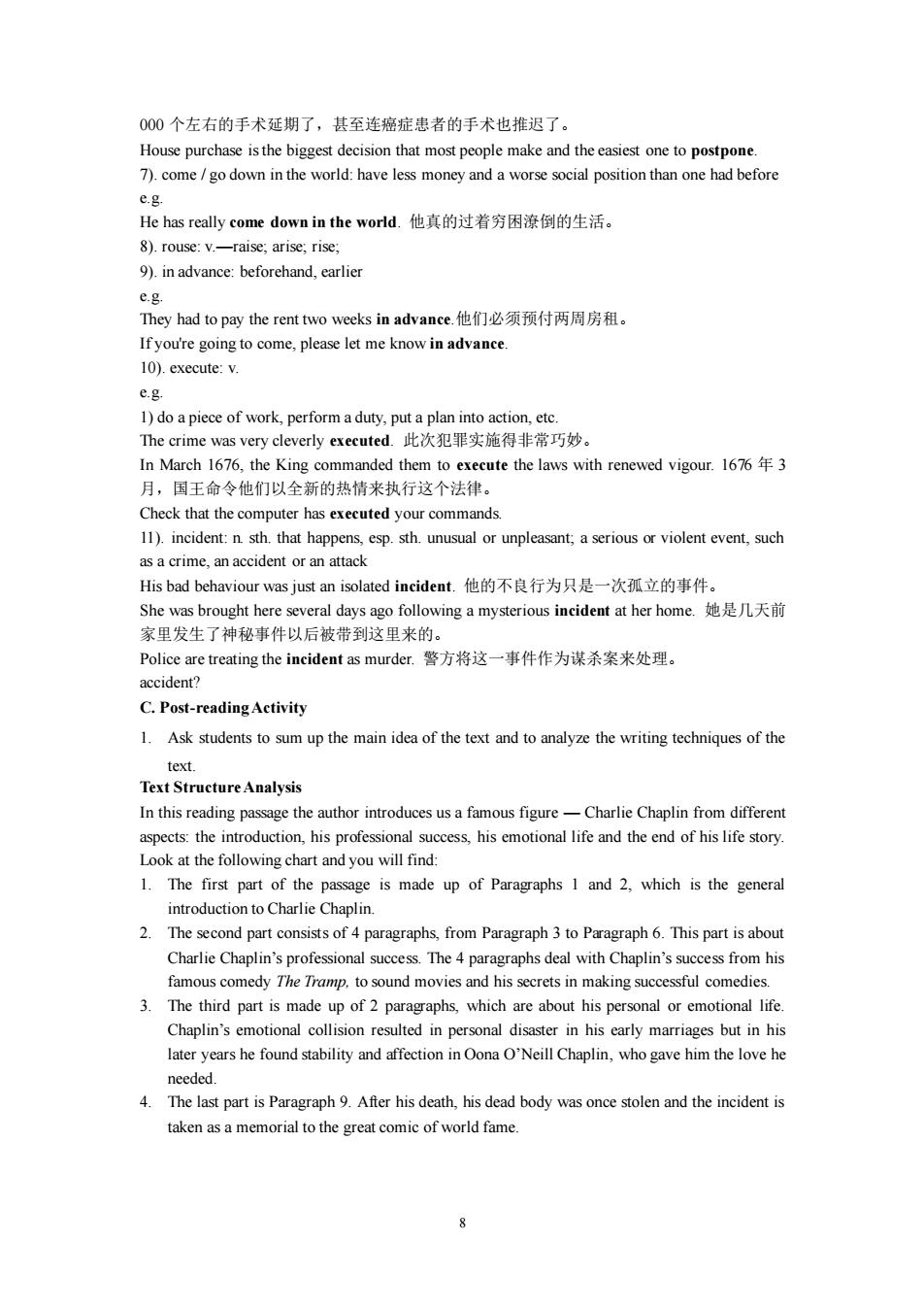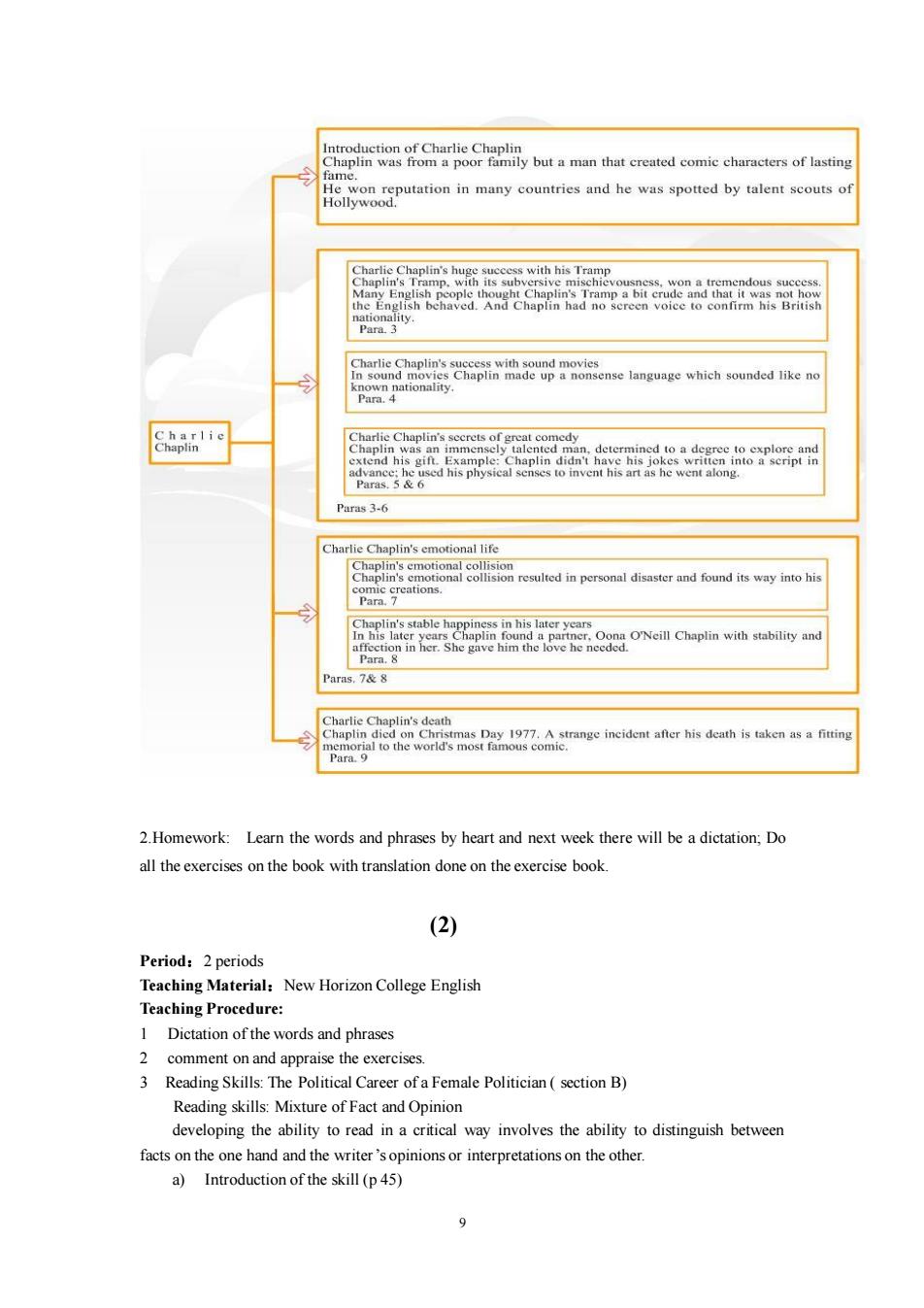
2.Homework:Learn the words and phrases by heart and next week there will be a dictation, Doall the exercises on the book with translation done on the exercise book.(2)Period:2periodsTeaching Material:New Horizon College EnglishTeaching Procedure:1.Dictation ofthewords and phrases2.comment on and appraise the exercises.3.ReadingSkills(SectionB)TheObligationsandResponsibilitiestoMarriageReadingbetweenthelines:usingcontextclues,common senseandyourknowledgeofthe world to guess the possible answers to the questions between the paragraphs.1)Introductionof theskill (P.16)2)Reading the samples (P.16)3)Practice the skill and (P.17)4)Doing the exercise on it(P.23)Note:There are three levels among the students. The students are given the tasks interms of their levels.Teaching Plan for Speaking and Writing Unit 2Teaching Objectives:The students will be able to:Practice on Frequency and Sequence1.Speaking: 1. Focus on the sentence patterns (P.8)2.Situational Conversations (P.11)3.Expressing Yourself (P.13)2.Writing: Every two weeks, the students are asked to write a paragraph according to thereading materials: the first period for studying the sample and the rules of the writing,andthesecondperiodsforpracticeTeachingPlanfor Unit2Charlie Chaplin (Section A)Period:2periodsTeaching Material:New Horizon College EnglishTeachingObjectives:Thestudents will beableto:Teaching Objectives1.Words, Phrasesand Expressionsof the Text(stress on the word-formation, and theusage of the phrases and the expressions)6
6 2.Homework: Learn the words and phrases by heart and next week there will be a dictation; Do all the exercises on the book with translation done on the exercise book. (2) Period:2 periods Teaching Material:New Horizon College English Teaching Procedure: 1. Dictation of the words and phrases 2. comment on and appraise the exercises. 3. Reading Skills (Section B) The Obligations and Responsibilities to Marriage Reading between the lines: using context clues, common sense and your knowledge of the world to guess the possible answers to the questions between the paragraphs. 1) Introduction of the skill (P. 16) 2) Reading the samples ( P. 16) 3) Practice the skill and (P.17) 4) Doing the exercise on it (P.23) Note: There are three levels among the students. The students are given the tasks in terms of their levels. Teaching Plan for Speaking and Writing Unit 2 Teaching Objectives:The students will be able to: Practice on Frequency and Sequence 1. Speaking: 1. Focus on the sentence patterns (P.8) 2.Situational Conversations (P.11) . 3.Expressing Yourself (P.13) 2. Writing: Every two weeks, the students are asked to write a paragraph according to the reading materials: the first period for studying the sample and the rules of the writing, and the second periods for practice. Teaching Plan for Unit 2 Charlie Chaplin (Section A ) Period:2 periods Teaching Material:New Horizon College English Teaching Objectives:The students will be able to: Teaching Objectives 1. Words, Phrases and Expressions of the Text ( stress on the word-formation, and the usage of the phrases and the expressions)

2.Sentence Structure(a: inversion of the sentence; b: It is +adj.to do...)3.Text Structure (a central topic/idea supported by different aspects/details ).Teaching Procedure:A.Pre-readingActivity(1OminutesWhat doyouknowabout Charlie Chaplin?What doyouwant toknowaboutCharlieChaplin?(Pairwork)B.While-readingActivity1Ask students some sign post questions to each paragraph to see how well the studentsunderstand eachparagraphandtrain Ss skimmingability.(Someof thequestions areonP.37Comprehension ofthetext)2 LanguagePoints:(refertoteachers'book)1).cut down: reduce the size of(sth.such as clothing,writing,etc.)e.g.I could cut yourfather's trousers downfor the boyYour article will have to be cutdown tofit into the bookThey've cut her hours down at work so she doesn't have much moneyIf an article is too long for the space allocated, you haveto cut it down2)..forgood:permanently,forevere.g.Thistimeshe's leavingforgood.这一次她将是永远地离开了。I'd likeanexcusetogetridofhimforgood.我需要一个借口将他永久开除。Afew shots ofthis drugcleared up the diseaseforgood3).revolt: v.1)(against)take violent action against thepeople inpowere.g.Finallythepeople revolted against themilitarydictatorshipThepeoplerevoltedagainsttheiroppressors.人民反抗其压迫者。2)reject the authorityof aperson or reject sth.,make(sb.)feelunpleasantly shocked or disgustede.g.Sherevoltedagainstherballettrainingatsixteen,她16岁的时候开始拒绝练芭蕾。4).trip (up): catch sb.'s foot and make him fall or almost fall; make a mistake; deliberately makesb. do thise.g.AsI passed, he stuck out a leg and tried to trip me up.5).coarse: a.rude and offensive, esp.about sexcoarsemanners粗鲁的举止coarselanguage粗俗的语言coarse speech粗俗的讲话ajacketmadeofverycoarsecloth用粗布做的夹克abeachofcoarsesand粗沙的海滩6).postpone: v. delay (an event), esp. arranging for it to take place at a later date or timee.g.Thetrialhas beenpostponed indefinitely。审判无限期地延期了。About 1,o00operationshad been postponed and even cancer patients were being delayed.大约1,7
7 2. Sentence Structure ( a: inversion of the sentence; b: It is + adj. to do.). 3. Text Structure (a central topic/idea supported by different aspects/details ). Teaching Procedure: A. Pre-reading Activity (10minutes) What do you know about Charlie Chaplin? What do you want to know about Charlie Chaplin? (Pair work) B. While-reading Activity 1 Ask students some sign post questions to each paragraph to see how well the students understand each paragraph and train Ss skimming ability. (Some of the questions are on P.37 Comprehension of the text) 2 Language Points: (refer to teachers’ book) 1). cut down: reduce the size of (sth. such as clothing, writing, etc.) e.g. I could cut your father's trousers down for the boy. Your article will have to be cut down to fit into the book. They've cut her hours down at work so she doesn't have much money. If an article is too long for the space allocated, you have to cut it down. 2). . for good: permanently; forever e.g. This time she's leaving for good. 这一次她将是永远地离开了。 I'd like an excuse to get rid of him for good. 我需要一个借口将他永久开除。 A few shots of this drug cleared up the disease for good. 3). revolt: v. 1) (against) take violent action against the people in power e.g. Finally the people revolted against the military dictatorship. The people revolted against their oppressors. 人民反抗其压迫者。 2) reject the authority of a person or reject sth.; make (sb.) feel unpleasantly shocked or disgusted e.g. She revolted against her ballet training at sixteen. 她 16 岁的时候开始拒绝练芭蕾。 4). trip (up): catch sb.'s foot and make him fall or almost fall; make a mistake; deliberately make sb. do this e.g. As I passed, he stuck out a leg and tried to trip me up. 5). coarse: a. rude and offensive, esp. about sex coarse manners 粗鲁的举止 coarse language 粗俗的语言 coarse speech 粗俗的讲话 a jacket made of very coarse cloth 用粗布做的夹克 a beach of coarse sand 粗沙的海滩 6). postpone: v. delay (an event), esp. arranging for it to take place at a later date or time e.g. The trial has been postponed indefinitely. 审判无限期地延期了。 About 1,000 operations had been postponed and even cancer patients were being delayed.大约 1

000个左右的手术延期了,甚至连癌症患者的手术也推迟了。House purchase is the biggest decision that most people make and the easiest one to postpone7).come/godown intheworld:haveless moneyand a worse social positionthanonehad beforee.g.Hehasreallycomedownintheworld.他真的过着穷困滚倒的生活。8).rouse:v.—raise, arise, rise,9).in advance:beforehand, earliere.g.Theyhadtopaytherenttwoweeksinadvance.他们必须预付两周房租。If you're going to come, please let me know in advance.10).execute:v.e.g.1)do a piece of work,perform a duty,put a plan into action, etc.Thecrimewasverycleverlyexecuted.此次犯罪实施得非常巧妙。InMarch1676,theKingcommandedthemtoexecutethelawswithrenewedvigour.1676年3月,国王命令他们以全新的热情来执行这个法律。Checkthat the computerhas executed yourcommands11). incident: n sth. that happens, esp. sth. unusual or unpleasant, a serious or violent event, suchas a crime,an accident or an attackHisbad behaviourwas justan isolatedincident.他的不良行为只是一次孤立的事件。Shewasbroughthereseveraldaysagofollowingamysteriousincidentatherhome.她是几天前家里发生了神秘事件以后被带到这里来的。Police aretreatingtheincidentasmurder.警方将这一事件作为谋杀案来处理。accident?C.Post-readingActivity1.Ask students to sum upthe main idea of thetext and toanalyze the writing techniques of thetext.Text Structure AnalysisIn this reading passage the author introduces us a famous figure —Charlie Chaplin from differentaspects: the introduction, his professional success, his emotional life and the end of his life story.Look at the following chart and you will find:1.The first part of the passage is made up of Paragraphs 1 and 2, which is the generalintroductiontoCharlieChaplin.2.The second part consists of 4paragraphs,fromParagraph3toParagraph 6.This part is aboutCharlie Chaplin's professional success.The 4paragraphsdeal with Chaplin's successfrom hisfamous comedy The Tramp, to sound movies and his secrets in making successful comedies.3.The third part is made up of 2 paragraphs, which are about his personal or emotional life.Chaplin's emotional collision resulted in personal disaster in his early marriages but in hislateryears hefound stabilityand affection in Oona O'Neill Chaplin,whogavehimtheloveheneeded.4.Thelast part is Paragraph9.Afterhis death,hisdead bodywas once stolen and the incident istaken as a memorial to thegreatcomic of world fame8
8 000 个左右的手术延期了,甚至连癌症患者的手术也推迟了。 House purchase is the biggest decision that most people make and the easiest one to postpone. 7). come / go down in the world: have less money and a worse social position than one had before e.g. He has really come down in the world. 他真的过着穷困潦倒的生活。 8). rouse: v.—raise; arise; rise; 9). in advance: beforehand, earlier e.g. They had to pay the rent two weeks in advance.他们必须预付两周房租。 If you're going to come, please let me know in advance. 10). execute: v. e.g. 1) do a piece of work, perform a duty, put a plan into action, etc. The crime was very cleverly executed. 此次犯罪实施得非常巧妙。 In March 1676, the King commanded them to execute the laws with renewed vigour. 1676 年 3 月,国王命令他们以全新的热情来执行这个法律。 Check that the computer has executed your commands. 11). incident: n. sth. that happens, esp. sth. unusual or unpleasant; a serious or violent event, such as a crime, an accident or an attack His bad behaviour was just an isolated incident. 他的不良行为只是一次孤立的事件。 She was brought here several days ago following a mysterious incident at her home. 她是几天前 家里发生了神秘事件以后被带到这里来的。 Police are treating the incident as murder. 警方将这一事件作为谋杀案来处理。 accident? C. Post-reading Activity 1. Ask students to sum up the main idea of the text and to analyze the writing techniques of the text. Text Structure Analysis In this reading passage the author introduces us a famous figure — Charlie Chaplin from different aspects: the introduction, his professional success, his emotional life and the end of his life story. Look at the following chart and you will find: 1. The first part of the passage is made up of Paragraphs 1 and 2, which is the general introduction to Charlie Chaplin. 2. The second part consists of 4 paragraphs, from Paragraph 3 to Paragraph 6. This part is about Charlie Chaplin’s professional success. The 4 paragraphs deal with Chaplin’s success from his famous comedy The Tramp, to sound movies and his secrets in making successful comedies. 3. The third part is made up of 2 paragraphs, which are about his personal or emotional life. Chaplin’s emotional collision resulted in personal disaster in his early marriages but in his later years he found stability and affection in Oona O’Neill Chaplin, who gave him the love he needed. 4. The last part is Paragraph 9. After his death, his dead body was once stolen and the incident is taken as a memorial to the great comic of world fame

Introduction of Charlie ChaplinChaplin was from a poor family but a man that created comic characters of lastingfame.He won reputation in many countries and he was spotted by talent scouts ofHollywood.Charlie Chaplin's huge success with his TrampChaplin's Tramp,with its subversive mischievousness,won a tremendous success.Many English peoplc thought Chaplin's Tramp a bit crude and that it was not howthe English bchaved.And Chaplin had no screen voice to confirmhis Britishnationality.Para.3CharlieChaplin'ssuccesswithsoundmoviesIn sound movies Chaplin made up a nonsense language which sounded like noknown nationalityPara.4CharlieCharlie Chaplin's sccrets of grcat comedyChaplinChaplinwas an immensclytalentedman,determined to a degreeto exploreandextend his gift.Example:Chaplin didn't have his jokes wrilten into a script inadvance;he uscdhis physical senses to invent his art as he went along.Paras.5&6Paras 3-6Charlie Chaplin's emotional lifeChaplin's cmotional collisionChaplin's emotional collision resulted in personal disaster and found its way into hiscomic creations.Para.7Chaplin's stable happiness in his later yearsIn his later years Chaplinfound a partner,Oona O'Neill Chaplin with stability andaffection in her. She gave him the love he needed.Para.8Paras.7&8Charlie Chaplin's deathChaplin died on Christmas Day 1977.A strange incident after his death is taken as a fittingmemorial totheworld'smostfamous comic.Para.92.Homework:Learn the words and phrases byheart and next week there will be a dictation, Doall the exercises on the book withtranslation done on the exercise book.(2)Period: 2 periodsTeachingMaterial:NewHorizonCollegeEnglishTeaching Procedure:1Dictation of the words and phrases2commentonand appraisetheexercises.3Reading Skills: The Political Career of a Female Politician ( section B)Reading skills: Mixture of Fact and Opiniondeveloping the ability to read in a critical way involves the ability to distinguish betweenfacts on the one hand and the writer'sopinions or interpretations on the other.a)Introductionoftheskill (p45)9
9 2.Homework: Learn the words and phrases by heart and next week there will be a dictation; Do all the exercises on the book with translation done on the exercise book. (2) Period:2 periods Teaching Material:New Horizon College English Teaching Procedure: 1 Dictation of the words and phrases 2 comment on and appraise the exercises. 3 Reading Skills: The Political Career of a Female Politician ( section B) Reading skills: Mixture of Fact and Opinion developing the ability to read in a critical way involves the ability to distinguish between facts on the one hand and the writer’s opinions or interpretations on the other. a) Introduction of the skill (p 45)

b)Reading the samples (P.46-48)Doing the exercise on it (p 52-53)c)TeachingPplanforSpeaking (oneperiod)Unit2Practicing Conversational SkillsTalking about position, direction and movementStep1:Read sentencepatterns (p24)Step 2: Make some communicative use of sentences. (p 25-27)Step 3: Pair work :Speaking Task 3on p 29TeachingPlanfor Unit3Reading and Writing CoursePeriod:2periodsTeaching Material:New Horizon College EnglishTeaching objectives:Students should beabletomaster new words, phrases and expressions used in the text. (Put the stress on the word1.building, collocation and the usage of the phrases and expressions)2.understand the text correctly and grasp the main idea3.learnaboutthesentencestructureandthetextstructure4.conduct a series of reading, listening ,speaking, translating and writing activities concerningthe theme of the textTeaching ProcedureA.Pre-readingActivity(IOminutes)1.Who are the main characters in thetext?(Pairwork)(JohnCallahan:welfareclient;Suzanne:social worker/caseworker)2.From the title,“Longing for a NewWelfare System"can you predict what the author will talkabout?1).:Problemsofthepresentwelfaresystem,2)newsystem3.Which part does the author give more space?(first one)4.Background information of thetextSocial welfare:Public assistance programs, commonly called welfare", provide cash or in-kind benefits forparticular categories of thefinancially needy.The U.S.welfare system operates on both thefederaland state levels.The federal welfare program is known as Social Security that provides benefits orassistance for childcare, disability, food and medical assistance (also known as Medicaid ) Thestate welfare programs, on the other hand, provide assistance to both individuals and localcommunities with state schooling and social insurance. U.S. welfare programs grew significantlyin the decades following World War Il, but increases in welfare costs during the 1960s and 1970sbrought into question the extent and quality of public assistance. In the early 1980s the Reagan10
10 b) Reading the samples ( P. 46-48) c) Doing the exercise on it (p 52-53) Teaching Pplan for Speaking (one period) Unit 2 Practicing Conversational Skills Talking about position, direction and movement Step 1: Read sentence patterns (p 24). Step 2: Make some communicative use of sentences. (p 25-27). Step 3: Pair work :Speaking Task 3 on p 29 . Teaching Plan for Unit 3 Reading and Writing Course Period:2 periods Teaching Material:New Horizon College English Teaching objectives: Students should be able to 1. master new words, phrases and expressions used in the text. (Put the stress on the word building, collocation and the usage of the phrases and expressions) 2. understand the text correctly and grasp the main idea 3. learn about the sentence structure and the text structure 4. conduct a series of reading, listening ,speaking, translating and writing activities concerning the theme of the text Teaching Procedure A. Pre-reading Activity (10minutes) 1. Who are the main characters in the text? (Pair work ) (John Callahan: welfare client; Suzanne: social worker/caseworker) 2. From the title, “Longing for a New Welfare System” can you predict what the author will talk about? 1). Problems of the present welfare system; 2)new system 3. Which part does the author give more space? (first one) 4. Background information of the text Social welfare: Public assistance programs, commonly called “welfare”, provide cash or in-kind benefits for particular categories of the financially needy. The U.S. welfare system operates on both the federal and state levels. The federal welfare program is known as Social Security that provides benefits or assistance for childcare, disability, food and medical assistance (also known as Medicaid ). The state welfare programs, on the other hand, provide assistance to both individuals and local communities with state schooling and social insurance. U.S. welfare programs grew significantly in the decades following World War II, but increases in welfare costs during the 1960s and 1970s brought into question the extent and quality of public assistance. In the early 1980s the Reagan